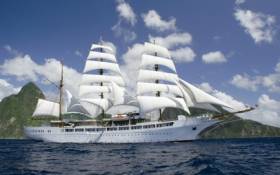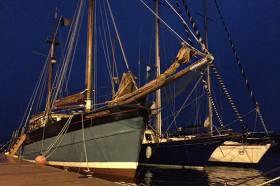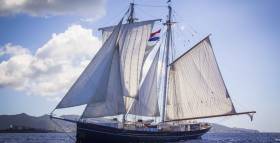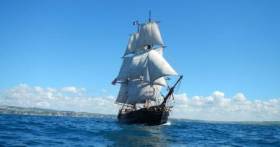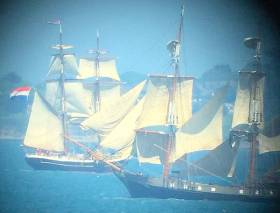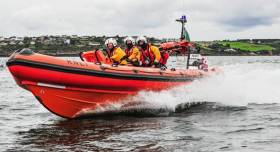Displaying items by tag: Tall Ships
Tall Ship 'Eye of the Wind' Bound for Ireland
In 1976 a sailing vessel – which has long been regarded as a legend among today’s last remaining tall ships – set off for its "second maiden voyage": forty years ago, the sail training vessel Eye of the Wind was given her current name, a distinctive look, and a new determination. In October, the seaworthy ship with the striking reddish brown canvas is going to moor in Dublin.
Captain: visit to Irish capital is long overdue
Cornel Greth is the captain of the ship. The 35-year-old skipper from Switzerland has been working aboard the ship for almost seven years now. “Before 2009 the Eye of the Wind sailed under various owners”, he explains. “That’s why there is no complete documentation of all past trips recorded in our logbooks. We assume that the last voyage to Dublin dates back to 1996 when the crew at that time sailed from Bristol to the “50 years of the Irish Navy” weekend. Certainly the forthcoming journey to the coast of Ireland must be the first one of its kind in nearly two decades!” The Captain and his crew arrive in Dublin on the 5th of October, after a one-week crossing of the Irish Sea from Oban / Scotland. Afterwards, the itinerary will take them onwards to the Netherlands before setting course for Spain and the Canary Islands.
The Eye of the Wind – a unique sailing legend with a Royal past
The ship’s more distant history is well documented all the better. Built as a gaff schooner in 1911 the ship was first named Friedrich and used as a cargo vessel. After passing through several different proprietors, a change of name, beaching and a fire in the engine room, the ship’s end seemed to be inevitable in 1970. Instead a British sailing enthusiast started to rig the ship anew. In 1976 the two-master with its new name Eye of the Wind was ready to sail the seas again.
On her first journey she sailed around the globe. In 1978 the Eye of the Wind had the honor of being the flagship for the renowned scientific expedition “Operation Drake”. HRH Charles, Prince of Wales himself steered the proud brig while he was patron of this almost two-year circumnavigation in the footsteps of the famous explorer and scientist Sir Francis Drake. Her imposing structure has also attracted the attention of the film industry. The Eye of the Wind has crossed the waters of film sets, featuring in several major Hollywood adventure films including „The Blue Lagoon“ and „White Squall“. Hollywood-stars like Brooke Shields and the Academy Award®-winners Tommy Lee Jones und Jeff Bridges were steering the ship.
Sail training program for young adults
Guests and trainees are welcome to join the crew on their sailing trips at all times. Previous sailing experience is not necessary, active participation in the daily routine on board is always carried out on a voluntary basis. “The sailors’ work and trade as a traditional custom is practiced aboard on a daily basis”, says Captain Greth. “We want to facilitate access to the principles of sail training and to the traditional way of seamanship especially for adolescents and young adults, boys or girls”, he underlines. Participants aged 16 to 25 years get the chance to join the crew as “trainees” at particularly favorable conditions.
Save the dates for arrival and departure in Dublin
Estimated time of arrival: October 05 (Wednesday) / departure: October 07 (Friday).
After departing from the Dublin Bay area the ship’s journey will continue to Rotterdam, further south to portside cities in Spain, and on to the Canary Islands.
Short profile Eye of the Wind
• Type: Brig
• Year of construction: 1911
• Length: 40.23 m [131 ft], Width: 7.01 m [22 ft]
• 2 masts; 750 m2 sail area
• 6 comfortable cabins for 12 guests
• Up-to-date safety standards
• Radio (worldwide), satellite phone, Fax
• Parlor with on-board library, deck parlor, sun deck
Rare Call of Five-Star Cruise TallShip Also Overnights
#CruiseTallShip – Standing out more than most, German premium brand, Sea Cloud Cruises ultra-luxury ‘windjammer’ Sea Cloud II, overnighted in Dublin Port as part of turnaround cruise, writes Jehan Ashmore.
The Hamburg based five-star operator of the modern yet majestic cruise ship, offers discerning guests an atmosphere of a very private yacht in which she can be also chartered. She is moored close to the Tom Clarke toll-bridge.
In addition cruise-lovers, limited to just 94 guests on board Sea Cloud II, can discover their passion for classic sailing ships, while also becoming devotees of great voyages. With a length overall of 117 m / 384 ft, the elegant lady of the sea has expansive decks and when under full sail, she totals 3,000 m² / 32,000 sq ft.
As for guest facilities they are spread over Sea Cloud II’s four decks. There is a lido deck with bar, lounge including laptops, a boutique, library, restaurant, all in which are imbued with stylish comfort, as to be expected given her 5-star status. In addition to the swim-platform, fitness area, gym and sauna.
Of the 47 outside cabins, here are further details of the range available. Of this total, 29 cabins feature a shower/WC, 16 junior suites with bathtub/WC and 2 luxury owner suites with bathtub and shower/WC).
Also on board is equipped a hospital zone.
Sea Cloud will depart for Campbeltown, Scotland, this afternoon. She is to return to Dublin and also Cork later this month. This will be a ten-night Dublin-Bilbao cruise beginning on 20 August followed by a next day port of call to the southern city.
On arrival in Bilbao on the northern Spanish coast (where in 2001 she was built at Figueras), guests can embark to begin a short five-day cruise to the Portuguese capital, Lisbon.
Three Irish Ships Sail In Company As Part Of The Waterford Sail Training Bursary Scheme
The Waterford Sail Training Tall Ship Bursary scheme is currently in full flow under the overall administration of Sail Training Ireland, with seventeen young people, including fourteen from Waterford, sailing into the Port of Waterford on Friday July 29th, some of them aboard local vessel Brian Ború (the only gaff-rigged Sail Training Vessel in Ireland) skippered by local Tall Ship Captain Liam Keating. The Naval Yacht Creidne will also be there on her first voyage for non-naval trainees since 2009/2010, while the Naval Yacht Tailte will be sailing in company with the other two, her crew including five young Naval Reservists (four from Waterford) skippered by Waterford Councillor Eddie Mulligan.
In all, a total of 22 young people have been on the three vessels for a six day voyage from Cork to Waterford. The Waterford Sail Training Bursary Scheme was established early in 2016 in partnership with Port of Waterford, Waterford Council, and Waterford Area Partnership to provide access to Sail Training voyages on tall ships and large sailing vessels for young people from the region.
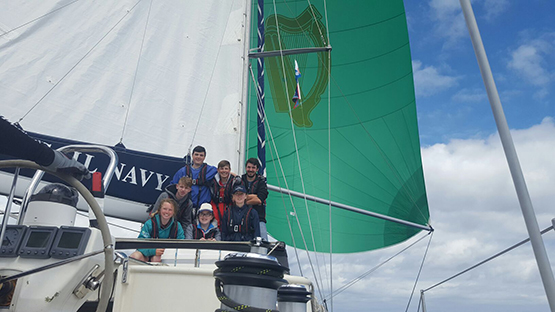 Fair winds and spinnaker set for trainees aboard Creidne
Fair winds and spinnaker set for trainees aboard Creidne
The first two 6-day voyages took place in May and June with young people aged 16-30 years, on board the Waterford based Brian Ború. Other trainees sailed on board the Dutch Tall Ship Morgenster, which visited the city on Friday 17th of June with a total of 32 young people from all over Ireland including 4 trainees from Waterford on board during a 19 day voyage, finishing in the Netherlands. This current voyage began last Sunday in Port of Cork and finishes on Friday 29th of June in Waterford, followed by a presentation of certificates in City Hall by the Mayor of Waterford, Councillor Adam Wyse.
 The Dutch Tall Ship Morgenster has played a key role in the success of the Waterford Sail Training Bursary scheme
The Dutch Tall Ship Morgenster has played a key role in the success of the Waterford Sail Training Bursary scheme
Visiting Dutch Tall Ship Wylde Swan is Open to the Public
Dutch tall ship Wylde Swan is in Dublin this weekend and is hosting an 'open ship' for members of the public from 16.00-18.00 today. All are welcome.
The Dutch sail trainer is berthed up river from the East link bridge.
Movie Star Tall Ship Sets Sail from Galway
Movie Star Tall Ship Phoenix passed through the Port of Galway's gates and on into the Atlantic Ocean yesterday.
Nine teenagers from Galway, Dublin, Belfast, and Ballyclare will be cooking, cleaning, and sailing alongside the professional crew as they make their way to Warrenpoint in Northern Ireland. The voyage, organised by the Atlantic Youth Trust, is aimed at highlighting the benefits and value of educating and developing young people through sailing ships.
Over the weekend the ship had thousands of guests, each learnt how the government has now included the Atlantic Youth Trust's plans for a new all island youth development tall ship in the Programme for Government. Once operational the new ship will play a vital role in introducing young people to the joys and opportunities in the maritime sector along with the wider personal development benefits of spending time at sea.
Tall Ship 'The Phoenix' En Route to Galway Harbour
One of the world's most famous Tall Ships, which has had a starring role in dozens of box office seafaring films and TV series, is on its way to Galway to take part in this week-ends big SeaFest maritime festival.
The Phoenix, left its home port of Charlestown Harbour in Cornwall yesterday and is due to arrive under full sail on Galway Bay on Thursday. Its weekend stay in Galway will be one of the highlights of SeaFest which is expected to attract thousands of visitors to the city.
The 112 foot long twin masted Brigantine which carries 4,000 square feet of sail, will be instantly recognisable to film goers from the role it played in the epic film "1492: Conquest of Paradise" the Ridley Scott directed fictionalized story of Christopher Columbus's discovery of the New World.
For its role in the film "The Phoenix" was converted into a 15th century caravel to accurately replicate Columbus's flagship "The Sancta Maria" and the conditions its sailors experienced on their historic voyage of discovery.
"The Phoenix" also has an extremely interesting maritime history having been built in Denmark in 1929 to serve as a Danish Evangelical Mission Schooner. She was involved in this mission work travelling from port to port carrying evangelical missionaries for 20 years before being retired in 1949.
In Galway festival goers will be able to visit "The Phoenix" and get a sense of what life was like on board a historic Tall Ship over the week end. 8 lucky young people will be able share in the experience of a lifetime by sailing on "The Phoenix" on a sail training voyage from Galway to Warrenpoint departing on 4th July organised by the Atlantic Youth Trust.
According to John Killeen, of SeaFest, (and Marine Institute Chairman) the week end will bring something of the excitement of the two great Volvo Ocean Race festivals to Galway and the arrival of "The Phoenix" – one of the world's most filmed and best known tall ships - will be one of the dramatic highlights.
"Weather permitting the "The Phoenix", which is now making its way across the English Channel, will arrive under full sail in the Bay sometime on Thursday and will have pride of place in the harbour during the festival. We are hoping, because of its association with so many famous films and TV series, that it will be a huge attraction and we will be encouraging people to some to send some time on board it".
"During the week 8 lucky young people will be selected – by competition – to sail on "The Phoenix" from Galway to Warrenpoint as part of SeaFest's role in promoting a love of the sea among young people".
Tall Ships Under Sail on Dublin Bay
Tall Ships Earl of Pembroke from the UK and Morgenster (Holland) are among a fleet of six boats entering Dublin Port this lunch time in a parade of sail to mark the start of the annual River Liffey Festival. Joining the Tall Ships in Dublin Bay are schooners Sprit of Oysterhaven and Celtic Mist. More on the Dublin Port Riverfest here.
#TitanicMaritime - Belfast City welcomes some of the Tall Ships back for the Titanic Maritime Festival a three day event (28-30 May) that begins today and includes this Spring Holiday Monday in the UK.
Groups of young people from across the city have been enjoying the challenge of life on the ocean waves, thanks to Belfast City Council’s Sail Training Initiative.
A total of 30 volunteers, aged between 16 and 28 and from all parts of the city, are taking part in series of voyages on board the tall ships Maybe and Morgenster. They were scheduled to call to ports such as Dublin, Liverpool, the Isle of Man, Derry/Londonderry, Galway, Cork, Oban, Carsaig on the Isle of Mull and Lamlash on the Isle of Arran.
Lord Mayor, Councillor Arder Carson, said: “These voyages will provide the participants with a unique, challenging and inspirational experience that increases their self-awareness and self-confidence, develops their teamwork and leadership skills and creates a strong sense of community responsibility, perhaps helping them to become future civic leaders.
The Lord Mayor added “As members of trainee crews, along with trainees from Dublin, Galway and Liverpool they will be an important members of the crew and their participation in all activities is essential to the smooth running of the voyage.”
During the voyages, the trainees will help in all aspects of life on board, including trimming sails, steering and navigation.
The Belfast Titanic Maritime Festival and for further details, click here.
#TallshipPublicTours - The United States Coast Guard Cutter trainee tallship USCGC Eagle sailed into Dublin Port this morning following the maiden Irish port of call of cruiseship Disney Magic.
The USS Eagle is on a summer tour training schedule and the last port of call was New London, Connecticut – Fort Trumbull. The barque is on a five day visit to Dublin before heading to London.
According to the US Embassy, the tallship is to moor upriver at Sir John Rogerson’s Quay and be open for free public tours on the following dates and times:
Thursday, May 26th: 3:30 p.m. – 7 p.m.
Friday, May 27th: 10 a.m. – 2 p.m.
Saturday, May 28th: 10 a.m. – 7 p.m.
Sunday, May 29th: 10 a.m. – 7 p.m.
Monday, May 30th: 10 a.m. – 7 p.m.
At 90 meters (295ft) in length, Eagle is the largest tall ship flying the stars and stripes and the only active square-rigger in United States government service.
Constructed in 1936 by the Blohm and Voss Shipyard in Hamburg, Germany, and originally commissioned as Horst Wessell by the German Navy, Eagle was a war reparation for the United States following World War II. The vessel is a three-masted barque with more than 6797 square meters (22,300 sqFt) of sail and 9.7 kilometers (6-mi) of rigging.
Eagle has served as a classroom at sea to future Coast Guard officers since 1946, offering an at-sea leadership and professional development experience as part of the Coast Guard Academy curriculum. During this sail, Eagle also hosts cadets from the Royal Malaysian, and Honduran Navies who, after they graduate with a 4-year degree from the U.S. Coast Guard Academy, will return to their respective countries to share the lessons learned with their services.
The last time Eagle visited Dublin, Ireland was 1996. After 20 years, Eagle is crossing the North Atlantic to visit this historical city again. After departing Dublin, Eagle will set her course for London, England.
For a continuous stream of information about Coast Guard Cutter Eagle, including port cities, tour schedules, current events and cadet and active duty crew-member photographs, follow the “U.S. Coast Guard Barque Eagle” Facebook page. All U.S. Coast Guard imagery is public domain and can be shared widely.
#RNLI - Crosshaven RNLI launched to reports of a man overboard from a visiting US Coast Guard cutter off Cork Harbour yesterday morning (Tuesday 24 May).
According to the station's Facebook page, the Crosshaven lifeboat was tasked alongside the local Irish Coast Guard unit and the Waterford-based coastguard helicopter Rescue 117 after the crewman fell overboard from the vessel conformed by gCaptain as the sail training barque Eagle.
However the operation was stood down shortly after launch as the tall ship mounted its own successful rescue of the casualty.
Eagle, which previously visited Irish waters in 2011, is expected in Dublin later this week before sailing to Britain and Portugal next month.



























